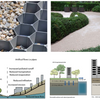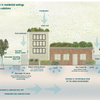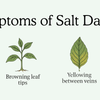Understanding your soil and the wicking process

Posted on: 16 August 2018
You may ask these questions:
- What do we mean by soil structure?
- What is the best potting mix for a wicking bed?
- What is soil biology and why is it important?
- What does a rich organic potting mix look and feel like?
- What balance of potting mix, organic matter/compost is required?
- Do I need to feed my soil?
What do we mean by soil structure?
This term refers to the arrangement of the solid parts of the soil and the pore spaces located between them. It is the shape that the soil takes based on its physical, chemical and biological properties. While soil structure is not the same as soil texture, there are similarities. Both affect the soil's drainage and aeration capabilities. A well-structured soil has a crumbly, or friable texture. This means that there is plenty of pore space to allow water and air to move through the soil. This is particularly important for wicking beds.What is the best potting mix for a wicking bed?
Choosing a potting mix with the best structure for wicking beds is very important. The action of wicking water requires the structure of the potting mix to be open, and friable to allow for free flow upwards from the water/air source below. Wicking action provides the ideal moisture level, which is conducive to microbial activity in the soil for healthy plant growth. A mix with 20% sand in it will assist the wicking action as it will allow the water to move more freely. The resulting open structured potting mix also allows for maximum root development in the root zone.What is soil biology?
Soil biology refers to the organisms and plant and animal matter that make up the soil. It is the breakdown or decomposition of this organic matter by the soil organisms that determine the soil’s characteristics, its structure, fertility and carbon storage capacity. Maintaining good soil biology can increase the nutrient availability, health and productivity of their soils.What does a rich organic potting mix look and feel like?
The best way to get the ‘feel’ of your soil/potting mix is to take a handful, feel the texture and have a good smell. A crumbly, rich coloured, sweet smelling, earthy mix is desirable. To test your potting mix structure, take a handful of moist potting mix, squeeze it and then release it. If the potting mix opens up and does not bind together it has an ideal structure.What balance of potting mix, organic matter/compost is required?
While potting mix provides the structure for the plants and in particular the root ball to grow, it does not contain all the nutrients and microbial populations needed to grow healthy plants. Organic matter such as mushroom compost, cow or chicken manure or compost from your own compost pile provide nutrients and microbes and are essential to add to the potting mix. Organic matter also affects moisture storage of the soil. Poor structure and low organic matter reduce the moisture storage capacity. If you are growing vegetables in your wicking bed we suggest a mixture of:- 70% potting mix
- 20% sand or ash
- 10% manure/organic material
Do I need to feed my soil?
Adding compost teas, worm teas and liquid sea minerals also enhance the available nutrients for the plants. We will cover this in more detail in a future blog post.
Set up your new garden bed with potting mix to approximately ¾ full and then lightly mix in your organic matter/ compost. Generous lashing of this organic matter is recommended.
TIP: A commercially available vegetable garden mix in bags or bulk from your landscape supplier is suitable.
Bulk potting mix from your landscape supplier can often be 25% of the price of the bagged product, however this is dependent on the volume you require. An average bed 2metre x 1metre with 25 cm of soil will be ½ cubic metre. This equals to 20 x 25L bags.
References: https://soilsforlife.org.au
-
Posted in
Category_Garden Wicking, Category_Project Groups>Commercial Projects, Category_Project Groups>Community Projects, Category_Project Groups>Horticulture Projects, Category_Project Groups>Landscape Projects, Category_Project Groups>Residential Projects, Category_Project Groups>School &, ELC Projects, WaterUps, WaterUps Featured








